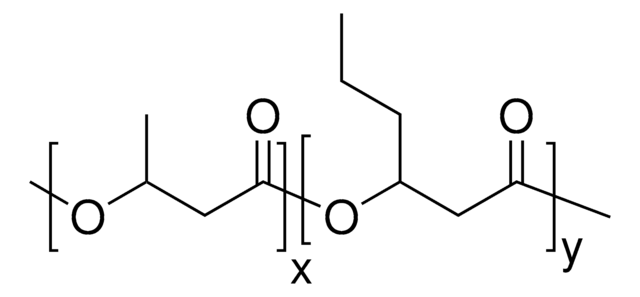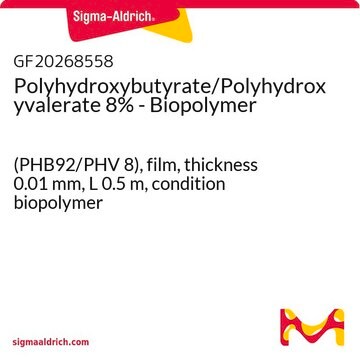363502
Poly[(R)-3-hydroxybutyric acid]
natural origin
Synonym(s):
(R)-3-Hydroxybutyric acid polymerized, PHB
Sign Into View Organizational & Contract Pricing
All Photos(1)
About This Item
Linear Formula:
[COCH2CH(CH3)O]n
CAS Number:
MDL number:
UNSPSC Code:
12162002
PubChem Substance ID:
NACRES:
NA.23
Recommended Products
transition temp
Tm 172 °C (DSC)
SMILES string
CC(O)CC(O)=O
InChI
1S/C12H20O6/c1-8(14)6-11(15)18-10(3)7-12(16)17-9(2)4-5-13/h5,8-10,14H,4,6-7H2,1-3H3
InChI key
QLACRIKFZRFWRU-UHFFFAOYSA-N
Looking for similar products? Visit Product Comparison Guide
Related Categories
General description
Biocompatible, biodegradable polymer.
Application
Poly[(R)-3-hydroxybutyric acid (PHB) is a biodegradable and biocompatible polymer produced by several bacterial species, owing to its low resorbability and tunable properties, it may find uses in a variety of applications such as tissue engineering, controlled release systems etc.
Storage Class Code
11 - Combustible Solids
WGK
WGK 3
Flash Point(F)
Not applicable
Flash Point(C)
Not applicable
Choose from one of the most recent versions:
Already Own This Product?
Find documentation for the products that you have recently purchased in the Document Library.
Molecular mass of poly [(R)-3-hydroxybutyric acid] produced in a recombinant Escherichia coli.
Kusaka S, et al.
Applied Microbiology and Biotechnology, 47(2), 140-143 (1997)
Proliferation and skeletal myotube formation capability of C2C12 and H9c2 cells on isotropic and anisotropic electrospun nanofibrous PHB scaffolds.
Ricotti L, et al.
Biomedical Materials (Bristol, England), 7(3), 035010-035010 (2012)
Engineering of Saccharomyces cerevisiae for the production of poly-3-d-hydroxybutyrate from xylose.
Sandstrom A G, et al.
AMB Express, 5(1), 14-14 (2015)
Andreas Wahl et al.
BMC microbiology, 12, 262-262 (2012-11-20)
Poly(3-hydroxybutyrate) (PHB) granules are important storage compounds of carbon and energy in many prokaryotes which allow survival of the cells in the absence of suitable carbon sources. Formation and subcellular localization of PHB granules was previously assumed to occur randomly
Daniel Pfeiffer et al.
Journal of bacteriology, 194(21), 5909-5921 (2012-08-28)
Poly(3-hydroxybutyrate) (PHB) granules are covered by a surface layer consisting of mainly phasins and other PHB granule-associated proteins (PGAPs). Phasins are small amphiphilic proteins that determine the number and size of accumulated PHB granules. Five phasin proteins (PhaP1 to PhaP5)
Our team of scientists has experience in all areas of research including Life Science, Material Science, Chemical Synthesis, Chromatography, Analytical and many others.
Contact Technical Service








